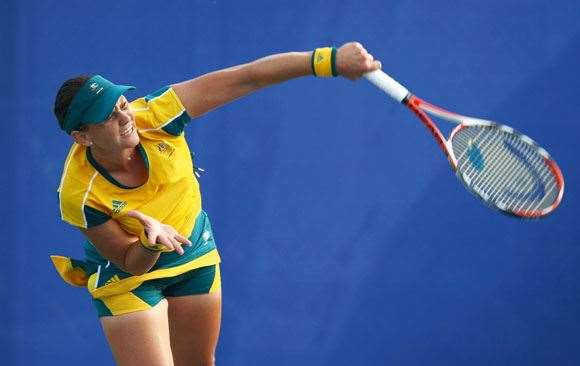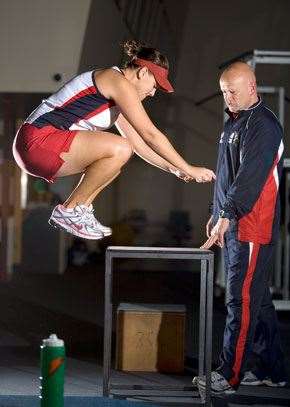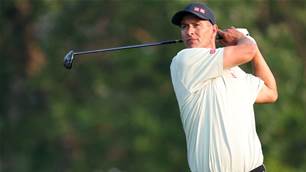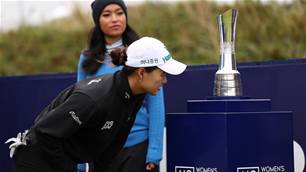Boiling down her recent and dramatic improvement, Dellacqua isolates “fitness and the mental side coming together”.
Boiling down her recent and dramatic improvement, Dellacqua isolates “fitness and the mental side coming together”.
 Dellacqua sends down a screaming serve for her country at the Beijing Games. Image: Stefan Postles
Dellacqua sends down a screaming serve for her country at the Beijing Games. Image: Stefan Postles“THIS IS THE MOST AMAZING performance you’ll ever see,” raved veteran commentator John Barrett of Casey Dellacqua’s 8-6-in-the-third upset of the seeded Patty Schnyder at the 2008 Australian Open. “You can tell your grandchildren you were there the day Casey Dellacqua came of age as a player.”If Barrett was gilding the lily with his first statement, he was bang-on with the second. After overhauling Schnyder from 6-4, 3-0 down, the lefty Dellacqua scored a rousing upset of former No. 1 Amelie Mauresmo to charge into the last 16 and emerge as the new top Australian. Finally an Aussie other than Lleyton Hewitt was creating excitement in the second week of a Slam. Even Casey’s Nan became a front-page celebrity and had her flag-wearing visage beamed around the world.It was all a far cry from Dellacqua’s baptism of fire in the 2006 Australian Open first round when, as a 20-year-old unknown, she faced world No. 1 Lindsay Davenport on Rod Laver Arena and was walloped 6-2, 6-1. The West Australian’s left-handed shot-maker’s flair was unmistakable, but undermined by her chunky physique. Three Opens on, a trimmer Dellacqua is lodged in the top 50, having peaked at No. 39 last season. She also emerged as a doubles force in 2008, reaching the French Open final and Wimbledon semis with different partners.“Fitness has been a huge factor in why I established myself as a top-50 player,” Dellacqua considers. “That match against Lindsay seems so long ago.” Boiling down her recent and dramatic improvement, Dellacqua isolates “fitness and the mental side coming together”.
Lashed by Lindsay
“Looking back, I wasn’t nearly ready to play Lindsay Davenport at the Australian Open. That match put me on the big stage for the first time and the huge learning out of it was how much work I had ahead of me. There were positives and negatives, but overall it was a positive experience in terms of moving ahead and moving forward in my career. I made a conscious effort to work on fitness because I always felt I had the game to do well.”
Game, set, slam
“In tennis you have to be ready from day one of the calendar; the first Grand Slam, the Australian Open, is only a couple of weeks into the year. Since the WTA has created a longer off-season, most players finish the year at the end of October, so we have a good eight weeks between seasons. Because of my [injured] shoulder, I finished the 2008 season in mid-September, earlier than I would have liked. From mid-October it was over to
the Australian Institute of Sport in Canberra and hard training until Christmas.”
 They look after Casey well at the AIS – and push her hard. Image: Stefan Postles
They look after Casey well at the AIS – and push her hard. Image: Stefan PostlesRacquets down
“I went pretty much six weeks without hitting. A lot of players need to keep hitting balls – they feel they have to keep their eye in. I feel I can put the racquets down for a while without a negative impact on my game. A big part of my game now is fitness and I feel it’s an area that will lead to more improvement. I might still hit for an hour or half-hour a week, just for fun. But November-December is when I incorporate the on-court work, building up to four hours of hitting a day.“Off-season is the time for the big picture stuff. We work on a lot of different things – increasing the endurance base, speed, power, but also a lot of rehab and injury prevention. I spent a lot of time getting shoulder mechanics right. Core exercises. All are included in the training block. You also spend a lot of time at the AIS Recovery Centre having physio and massage.“I love playing other sports, so I try to incorporate different activities, even if it’s just kicking a footy or playing basketball. It’s important to keep motivated during a large training block.”
Just do it all
“Tennis demands it all: power, strength, agility, speed and stamina. We work on everything. I’ve always been naturally strong, so my strength work is just weights in the gym and jumping exercises for power. Endurance work is mixing in some long-distance runs. For agility, there’s on-court patterning and drills with short sprints. Interval training, for me, best simulates match conditions and the on-off nature of tennis. You’ll do a series of drills – 30 seconds of intensity, then a break. You set the time, so extending to 45 seconds for clay court tennis or shortening it to 15 seconds, in preparing for Wimbledon, is very realistic and a good way to adapt to different surfaces.”
Fuelling up
“At tournaments, I’m thinking energy and some carbohydrates the night before a match. In training, I probably watch more what I eat, but it’s easy to eat well at the AIS – we have a nutritionist and prepared meals on-site. When you’re on the road – at airports, restaurants – it’s hard sometimes to get the foods you want. But I’m not a huge sweet tooth. My favourite splurge would be a simple glass of wine or a beer in summer. When I’m travelling, I rarely indulge – plus I’m mostly on my own. But it’s nice to reward yourself.”
All-year maintenance
“During the year, it’s really hard to find time to train. You’re practising and playing every day, so you don’t exactly lose fitness, but it’s a different type of fitness. If I lose early in the week, I hit the gym. It’s really hard to make plans because everything depends on your playing schedule and how long you’re in the tournament. You just fit in as much as you can when you have the time.”
 Short sprint drills help maintain Casey’s power. Image: Stefan Postle.
Short sprint drills help maintain Casey’s power. Image: Stefan Postle.World’s best practice
“When it comes to on-court practice, I like quality over quantity. I’d rather do a great 90 minutes and finish on a positive note, rather than thrash myself. On match days, I’ll warm up for half an hour beforehand, play the match, then work on what I didn’t do particularly well in the match. In full-on training, I spend three or four hours a day on court. Usually in the morning I’ll work on drills and specifics with [coach] Nicole Pratt. In the afternoon, it’s practice sets with another player. In that time, we still work pretty hard.“You don’t need hours and hours on the practice court, getting tired and frustrated. There are definitely times you need to push through on the practice court and work through problems. But mostly it’s about having a purpose or goal to the session.”
Practise as you play
“From hitting with the top girls, the way they train is the way they play. The most intense practice I’ve ever had was with [Japanese veteran and former top tenner] Ai Sugiyama. “Intensity in practice is something I need to improve on. I’m a relaxed person, even if I’m playing a lot of matches. It’s something I’ve learned from [former Aussie No. 1] Pratty. She’s keyed me up for some matches and definitely helped me become a better player. Pratty is the complete opposite to me. I have so much respect for her and loved watching her compete. She’s helped me a lot – she knows most of the players out there and is good with devising a specific game plan going into a match. I’m learning a lot. We’ve worked together since March.“On the practice courts, you do watch what everyone else is doing. Players are sometimes secretive with their practice and that’s understandable – you definitely don’t want to share around the things you’re working on. Many of the girls have male coaches and hitting partners for the nuts-and-bolts practice sessions; but if they need practice sets they’ll hit with another girl. Now that I’m in the top 50, people want to practise with me. I know part of it is that they want to figure out my game.”
Forget fads
“Tennis is quick to take up any new development in training, equipment or sport science. It does become a bit faddish. The latest buzzword is Spanish drills. Basically, it’s hand-fed drills and you’re on the baseline working side-to-side and looking to improve net clearance, consistency, pace of shot and stamina, depending on the drill. You do wonder why countries like Spain and Russia produce so many quality players, and so young. When I was 16, 17, there’s no way I was at the level of Russian girls the same age. It takes Australians longer to mature – at 23 to 25 is when Aussies really develop.“Tennis is so individual. You keep an eye out for what others are doing but physically, mentally and technically, everyone really focuses on what works for them.”
– Suzi Petkovski
Related Articles

Feature Story: Moving the Needle

Scott headed home for Australian majors













